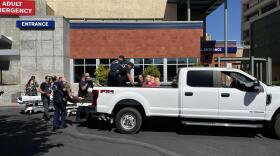BY AMY KINGSLEY -- The first stop for psychiatric patients in crisis is usually the closest emergency room. And upheaval at Rawson-Neal psychiatric hospital in the wake of the busing scandal has made that first stop longer, challenging hospitals’ ability to treat patients with medical needs, says Dr. Dale Carrison.
Carrison, Chief of Staff at University Medical Center, declared an internal disaster last week after its emergency center became overwhelmed with psychiatric patients. The hospital stopped accepting ambulances for 12 hours.
Almost half the beds in the adult emergency department were taken by psychiatric patients who were waiting to be transferred to Rawson-Neal. Carrison said recent changes in policy have slowed the intake process, and left emergency departments holding the bag.
“With the mentally ill patients … those people stay two, three days, sometimes five or six days in the emergency department or in the hospital,” Carrison said. “So an emergency department that’s not operating really efficiently can turn a bed over every six hours. An emergency department that’s operating efficiently can turn a bed over every four hours. So you can see for every patient that’s there for 24 hours, even if you’re slow, then you’ve not been able to see four other patients medically.”
Psychiatric patients have been crowding emergency departments for years. In 2004, the county manager declared an emergency, and things improved when the state expanded mental health facilities. But they have since cut the mental health budget by millions of dollars, and the number of patients stuck in emergency departments has skyrocketed.
The problem can’t be solved without a serious investment in resources for the mentally ill, Carrison said.
“Let’s say Rawson-Neal takes 35 patients a day, and there’s 105 holding,” Carrison said. “So, if they take 35 every day – what’s left? They still have 70 patients left. So it’s a situation where you can’t catch up. It’s like a funnel, and the large end of the funnel is the emergency departments and the small end of the funnel is the mental health facilities.”
The problem is compounded by the lack of follow-up care, Carrison said.
“It’s a revolving door,” Carrison said. “Many of our patients come and go, come and go, come and go.”
And right now, more patients are coming than going. The state has placed a psychologistat UMC to alleviate the problem. Carrison said it will take some time to see if that works.
GUEST
Dr. Dale Carrison, Chief of Staff, University Medical Center








